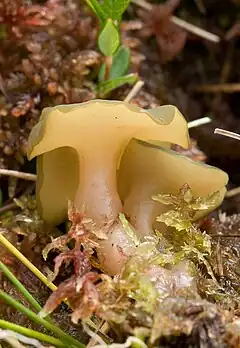| Sarcoleotia | |
|---|---|
 | |
| Ascocoryne turficola | |
| Scientific classification | |
| Kingdom: | |
| Division: | |
| Class: | |
| Order: | |
| Family: | |
| Genus: | Sarcoleotia S.Ito & S.Imai (1934) |
| Type species | |
| Sarcoleotia nigra S.Ito & S.Imai (1934) | |
| Species | |
|
S. globosa | |
Sarcoleotia is a genus of fungi in the earth tongue family Geoglossaceae. There is no known common name.
History
The genus was first described by Japanese mycologists Seiya Ito and Sanshi Imai in 1934,[1] who separated Sarcoleotia from Leotia Pers. based on the fleshy, non-gelatinous ascocarps and subcylindrical ascospores. Sarcoleotia nigra was described as the type species in the same publication from collections made in Hokkaido, Japan. Maas Geesteranus created S. platypus by transferring Helvella platypus DC. into the genus.[2] Korf transferred Mitrula globosa to the genus in 1971, creating S. globosa.[3] Dennis transferred Coryne turficola to the genus in 1971.[4] Lastly, Rahm reported "Sarcoleotia clandestina" from Switzerland in 1975, but this name is regarded as nomen nudum as no valid description of the species exists.[5]
Some debate exists over the accepted number of species in Sarcoleotia. Maas Geesteranus considered S. nigra a later synonym of S. platypus.[2] Korf [6] transferred S. turficola to the genus Ascocoryne based on gelatinous tissue in the ascocarp. Schumacher and Silvertsen recognized only a single species, S. globosa.[7] Recent molecular evidence indicates that the genus is most closely associated with Geoglossaceae.[8][9][10]
Habitat and distribution
Sarcoleotia globosa is reported by Schumacher and Silvertsen as having a "more or less transcontinental northern circumpolar boreo-oroarctic and arctic distribution", citing records from Norway, Sweden, Finland, Iceland, Greenland, Germany, Belgium, the Netherlands, Japan, and Canada.[7] S. globosa has also been reported from Denmark.[11] S. globosa is also reported cool temperate zones ranging from the Pacific Northwestern United States (Washington and Oregon) and Colorado.[12] S. nigra was described from Japan and has been reported from Argentina [13]
S. globosa has been reported from both calcareous areas and rich soil types in Europe,[7] and acidic-nutrient poor soils in North America.[14] S. globosa has been recorded mostly from disturbed areas and primary or secondary successional habitats, almost always fruiting in areas colonized by bryophytes.[12] S. globosa is also reported from burned sites.[7]
Conservation
The conservation of Sarcoleotia has not formally been assessed on a global scale, though given its widespread distribution and ability to survive in varied habitats, it is probably of low concern.
References
- ↑ Imai S. (1934). "Studies on the Geoglossaceae of Japan". Transactions of the Sapporo Natural History Society. 13: 179–184.
- 1 2 Maas Geesteranus RA. (1966). "On Helvella platypus DC". Koninklijke Nederlandse Akademie van Wetenschappen, Series C. 69: 191–203.
- ↑ Korf RP (1971). "Discomycetes and Tuberales". In Ainsworth GC; Sussman A; Sparrow FK (eds.). The Fungi: An Advanced Treatise. Vol. 4. Academic Press.
- ↑ Dennis RWG. (1971). "New or interesting British microfungi". Kew Bulletin. 25 (2): 335–374. doi:10.2307/4103238. JSTOR 4103238.
- ↑ Rahm E. (1975). "Geoglossaceae im Hochtal von Arosa (II)". Schweizerische Zeitschrift für Pilzkunde. 53: 40–43.
- ↑ Korf RP. (1971). "Some new discomycete names". Phytologia (21): 201–7.
- 1 2 3 4 Schumacher T, Silvertsen S. 1987. Sarcoleotia globosa (Sommerf.:Fr.) Korf, taxonomy ecology and distribution. In: Larsen GA, Ammirati JF, Redhead SA (eds.), Arctic and Alpine Mycology 2. Plenum Press, New York and London
- ↑ Wang Z; Binder M; Schoch CL; Johnston PR; Spatafora JW; Hibbett DS. (2006). "Evolution of helotialean fungi (Leotiomycetes, Pezizomycotina): A nuclear rDNA phylogney". Molecular Phylogenetics and Evolution. 41 (2): 295–312. doi:10.1016/j.ympev.2006.05.031. PMID 16837216.
- ↑ Schoch CL; Wang Z; Townsend JP; Spatafora JW. (2009). "Geoglossomycetes cl. nov., Geoglossales ord. nov. and taxa above class rank in the Ascomycota tree of life" (PDF). Persoonia. 22: 129–136. doi:10.3767/003158509x461486. PMC 2776753. PMID 19915689.
- ↑ Hustad VP; Miller AN; Moingeon J-M; Priou J-P. (2011). "Inclusion of Nothomitra in Geoglossomycetes" (PDF). Mycosphere. 2 (6): 646–654. doi:10.5943/mycosphere/2/6/5.
- ↑ Hansen L, Knudsen H. 2000. Nordic Macromycetes Vol. 1: Ascomycetes. Nordsvamp, Copenhagen.
- 1 2 Jumpponen A; Weber NS; Trappe JM; Cácares E. (1997). "Distribution and ecology of the ascomycete Sarcoleotia globosa in the United States". Canadian Journal of Botany. 75 (12): 2228–31. doi:10.1139/b97-933.
- ↑ Gamundi I. (1979). "Subantarctic Geoglossaceae II". Sydowia (32): 86–98.
- ↑ Hansen L; Knudsen H, eds. (2000). Nordic Macromycetes. Vol. 1. Copenhagen: Nordsvamp. ISBN 978-8798396123.